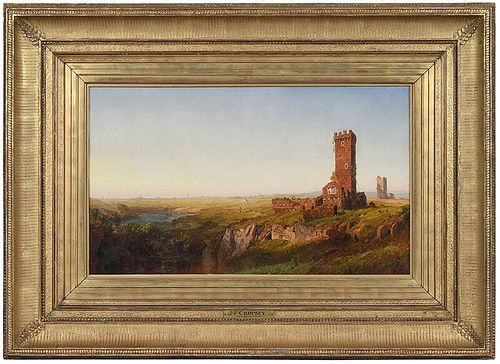(American, 1823-1900)The Campagna of Rome, 1874, signed and dated lower right "JF Cropsey 1874", 18 x 30 in.; fine period gilt wood liner in fine possibly reproduction gilt wood and composition frame, 32-1/4 x 44-1/4 in. - Note: Jasper Francis Cropsey was raised on his family’s hundred-acre farm in Staten Island. The artist began his career as an apprentice to architect Joseph Trench, where he painted structural images in watercolor. William T. Ranney and William Sidney Mount recognized young Cropsey’s emerging talent, and they encouraged him to embrace painting in oil. As a result, he began to create beautiful landscapes, a subject he would favor, and for which he would become famous. Cropsey’s paintings were well received following his first exhibitions at the Apollo Association (later known as the American Art Union) and the National Academy of Design (1843). As a testament to his success, he was elected an Associate of the National Academy in 1844, beginning a fifty-year career as one of America’s premier landscape artists. In 1847, he traveled abroad for the first time - visiting England, France, Switzerland, and Italy with his new bride, Maria Cooley. In 1851, he was elected a full member of the National Academy. With this new title, the ambitious artist sought inspiration from foreign land. The thrifty Cropsey held a studio sale in 1856 to finance a second trip to Europe. The artist and his family then settled in England and remained there for seven years. During this substantial period abroad, he established himself in the local community and socialized with leading artists and art-theorists of the day, including John Ruskin and Sir Charles Eastlake. Despite the distance, Cropsey maintained his American connections, patronage, and exhibition schedule to promote his work at home. In 1866, three years after the artist’s return to the United States, Cropsey purchased forty-five acres of land in Warwick, New York. By 1869, construction was completed on “Aladdin,” a house that he designed for his family. The twenty-nine-room mansion with a painter’s studio became the artist’s retreat for fifteen years, where he spent each summer painting scenes of the surrounding landscape. However, the home proved to be too costly, and by 1884, the property passed completely out of his hands. In 1885, the artist and his family settled in Hastings-on-Hudson, New York. Their home is still owned by Cropsey descendants, who have maintained his studio and established a study center for his life and work. The artist made his only trip to Italy during his first European sojourn. He kept a studio in Rome for part of 1848, and then moved on to Naples. While there, Cropsey ventured on several sketching trips along the coast to towns such as Amalfi, Salerno, and the island of Capri. He exhibited these works at the National Academy of Design and the Pennsylvania Academy of the Fine Arts. His Italian landscapes were popular amongst his American audience. As a result, he continued to paint scenes based on his sketches of Italy long after his return home, as is the case with the present image. Here, Cropsey depicts the vacillating landscape of the Roman Campagna, a rural area in central Italy. During the Eighteenth, Nineteenth, and Twentieth Centuries, the alluring scenery invited tourists from Europe and America to enjoy the regional enchantments. During the ancient Roman Empire (25 BCE – 285 CE), this province supported diverse agricultural growth and residential life. However, the climate ultimately evolved during the Tenth Century and left several structures in ruins. In the right foreground of the image, ruins of a medieval watch tower stand strong as a testament to the land’s extensive history. The advanced age of the structure is further indicated by the long green plants that wrap around its surface. In this scene, the artist presents the overwhelming landscape with compositional balance and harmony. He contrasts the tall structure on the right with voluminous rocks in the left foreground. In addition, the luminism throughout the image indicates that it is likely the afternoon. His focus on the grass, rocks, and sky is drastically juxtaposed with the petite figures and urbanscape in the background, relating man’s past and present presence within nature. This painting is referenced with positive commentary in several prominent journals such as theThe Artists’ Fund Society, The New York Times, and The Aldine. One critic exclaimed in one of many favorable comments on the piece: “A view of the Roman Campagna, with distant view of Rome, and in the foreground the crumbling castellated fragments of some Ostrogothic thief’s stronghold. It is gorgeous in color and good in distance.” 1 A preparatory drawing of this image titled Outskirts of Rome (1849) is in the collection of the Museum of Fine Arts, Boston. Many of Cropsey’s paintings of the Italian landscape can be seen in museum collections worldwide, including View of Nemi (1879, Newark Museum of Art), Italian Landscape (1860, Museum of Fine Arts, Boston), and Italian Landscape (1847-49, National Academy Museum).Accompanied by a facsimile of a letter discussing the recent purchase of the painting from Florence Levins of The Newington-Cropsey Foundation, Hastings-on-Hudson, dated March 5, 1993. Exhibited: Artist's Fund 14th Annual Sale, New York, NY, 1874, as Ruins on the Roman Campagna with Rome in the Distance, no. 53; "The Arcadian Landscape, Nineteenth Century American Painters in Italy", University of Kansas Museum of Art, Lawrence, Kansas, Npvember 4-December 3, 1972, cat. no. 17, illustrated.Literature: “Artists’ Fund Exhibition - The Private View,” New York Times, January 18, 1874, p. 3; “Artists’ Fund Society,” New York Evening Post, January 20, 1874 (as Ruins on the Campagna, with Rome in the Distance); “City Intelligence: The Artist’s Fund Sale.” New York Evening Post, January 28, 1874, p. 2 (as Ruins on the Roman Campagna); “Art: Artists’ Fund Exhibition,” The Aldine 7, April 1874, no. 88 (as Ruins on the Roman Campagna, with Rome in the Distance); William S. Talbot, Jasper F. Cropsey 1823-1900, PhD dissertation, New York University, 1972. (New York: Garland Publishing, 1977), pp. 207; 451-452, no. 184, illus.; Kenneth W. Maddox, An Unprecedented Eye: The Drawings of Jasper E. Cropsey (Yonkers, NY: The Hudson River Museum,) 1979, p. 34; A.M. Speiser, Jasper Francis Cropsey, Catalogue Raisonné. Works in Oil, vol. 2 (New York: Newington Cropsey Foundation, 2016), p. 163, no. 1210; Anthony M. Speiser, ed., Jasper Francis Cropsey Catalogue Raisonne, Works in Oil, Volume II: 1864 -1884, (New York: Newington-Cropsey Foundation, 2013), p. 163, no. 1210. - Provenance: Robert Ingham; Kende Galleries at Gimbel Brothers, Robert Ingham sale, February 16, 1946, catalog no. 19; Dr. Frederick Mont (A.F. Mondshein); gifted to Los Angeles County Museum of Art, Los Angeles, California, 1947 (LACMA label verso); Berry-Hill Galleries, New York, NY sold 1993: Private North Carolina Collection
Condition
linen lined, approximately three small areas of retouch, additional retouch at edges mostly under frame; frame with minimal wear and small areas of regilt and abrasions



















